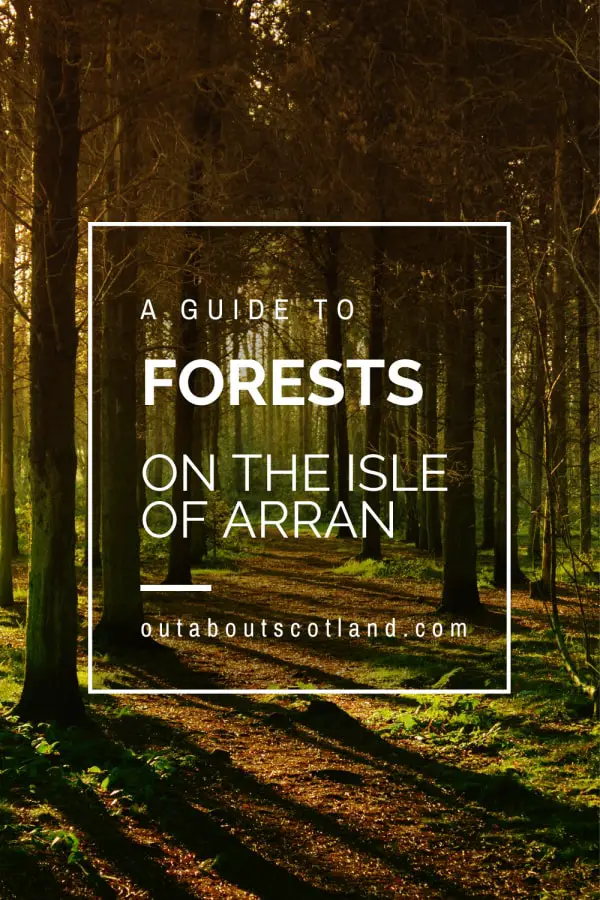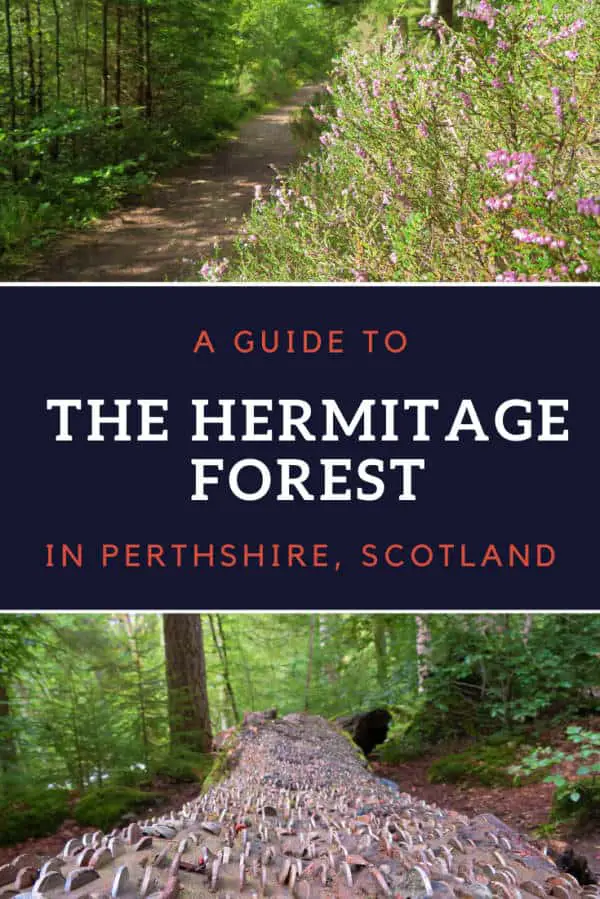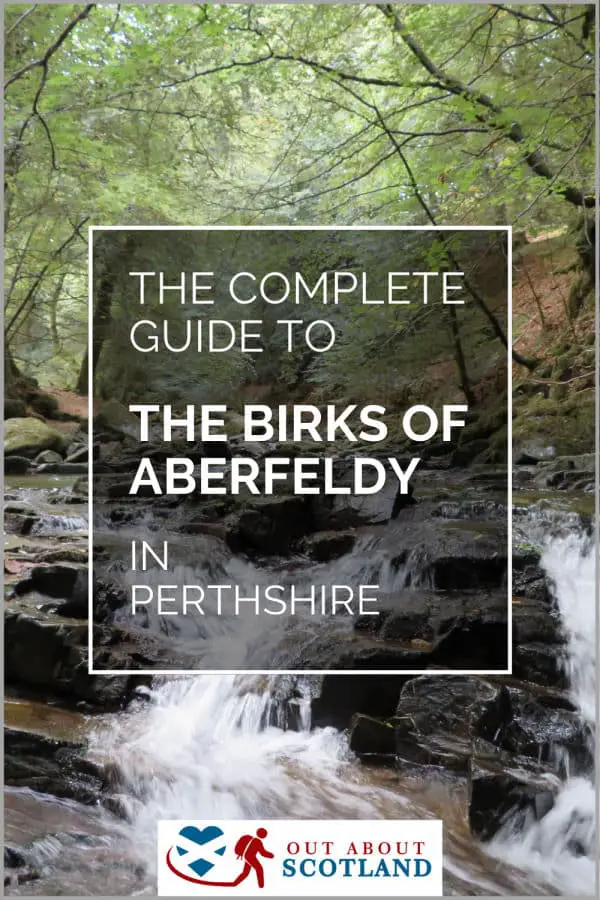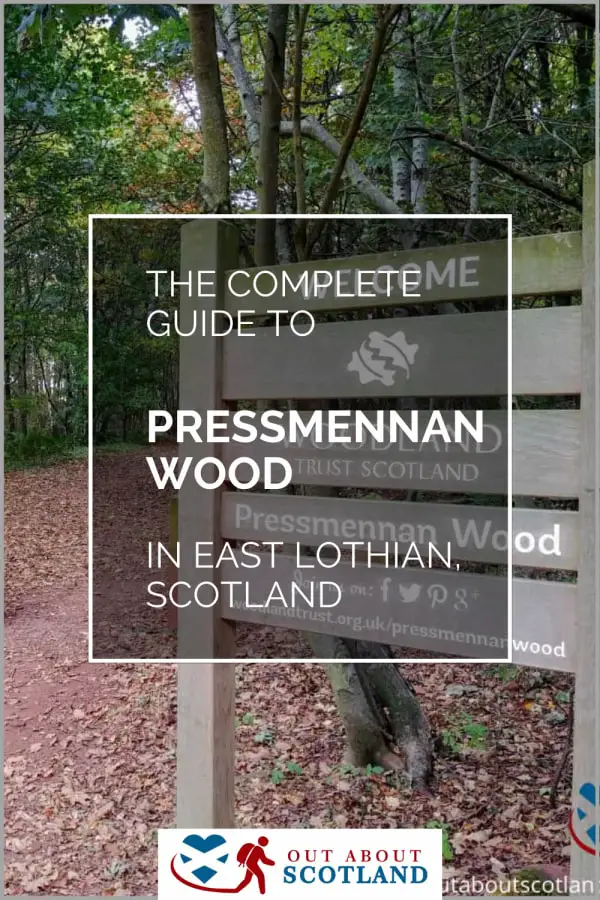There are six forest parks in Scotland: Glenmore, Argyll, Galloway, Tweed Valley, Queen Elizabeth, and Tay. Each park comprises a group of separate forests, all of which are free for the public to access. Discover the best forests in Scotland, where they are, and what facilities they have in this complete visitor guide, which includes information about Scotland’s woodlands.
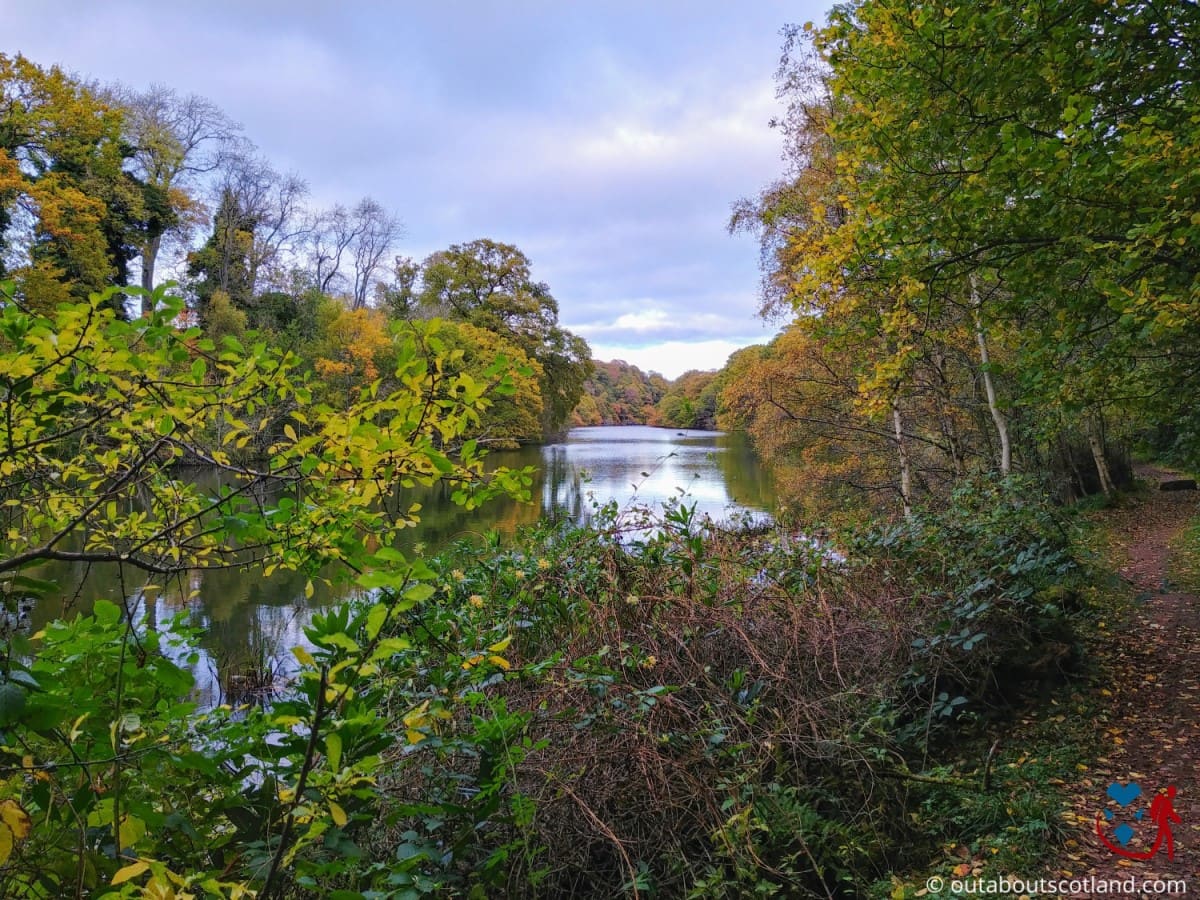
Forests in Scotland
Scotland’s trees are mostly broadleaved in the south of the country, but as you move further north they slowly transition into firs – many of which are over 200 feet in height. Sadly, the majority of the ancient forests in Scotland were lost to the timber industry in the 19th century and by the First World War, only 5% of the landscape was wooded. However, times are now changing and an intense regeneration programme is slowly but surely replanting those lost trees.
You can still see remnants of Scotland’s ancient woodland in Perthshire (which is known as the ‘Big Tree Country’) and some trees there are thought to be at least 5,000 years old. The majority, though, were planted after the Forestry Commission was set up in 1919 which subsequently decided to replant the countryside with fast-growing non-native specimens.
Of all the trees in Scotland, only 31 species are actually native – including willow, whitebeam, birch, cherry, Scots pine, juniper and yew – with the remainder being foreign spruce, pine and larch, but at least those non-native trees offer a safe habitat for Scotland’s native wildlife.
Before I continue, I probably need to explain that we don’t have just six forests here in Scotland, but we do have six forest parks: Glenmore, Argyll, Galloway (the biggest forest park in the UK), Tweed Valley, Queen Elizabeth, and Tay. Each park is a group of forests centred in a specific region, each of which is managed by the government-backed Forestry and Land Scotland (FLS) agency.
Now that we know a wee bit about Scotland’s forests and who looks after them, let’s take a deeper look at some of the forest parks you can visit.
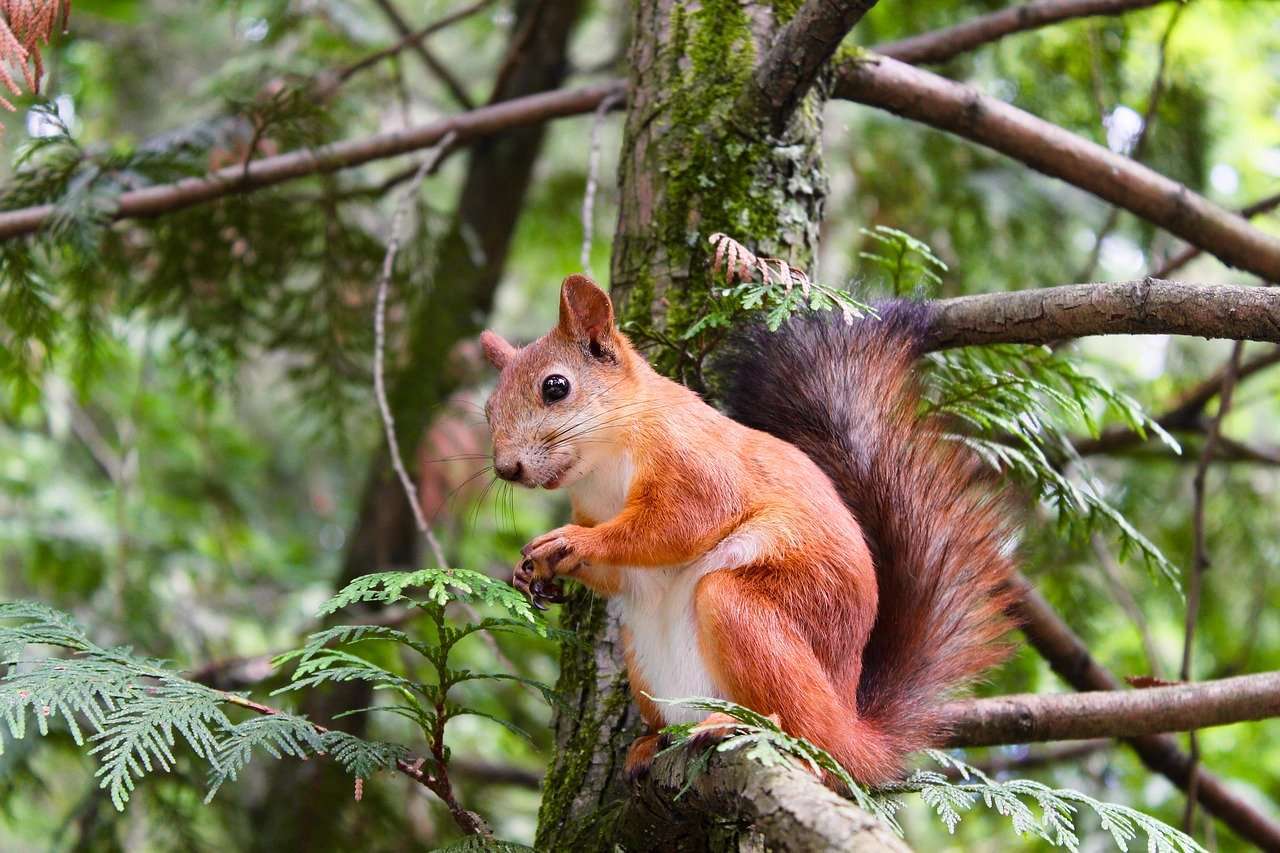
Protect Your Family From Scotland's Biting Midges
- Powerful, reliable protection for up to 8 hours
- Water- and sweat resistant
- Repels midges, mosquitoes, horse flies, sand flies, fleas and ticks
- Safe for use on adults, children over 30 months and pregnant women
- Non-sticky, moisturising with a pleasant fragrance
- Packaging may vary
Argyll Forest Park
Benmore Botanic Garden
How to get there: Postcode PA23 8QU. If you drive there you’ll find a free car park at the gardens which are located seven miles north of Dunoon, just off the A815. Alternatively, you can take one of the buses operated by West Coast Motors which runs to the garden from Dunoon. The bus ride takes approximately 20 minutes.
Facilities: Visitor centre with gifts and souvenirs. Café. Toilets. Car park. Guided tours on foot and in vehicles for the elderly.
Highlights: The Benmore Botanic Gardens are located in the heart of Argyll Forest Park.
Unlike the other forests in this list, Benmore is a carefully managed mix of plants and trees from across the globe so you’ll be able to see a variety of species obtained from the Orient, the Himalayas, and the Americas as well as a fine collection of native Scottish trees.
The gardens are absolutely enormous and cover upwards of 120 acres so there are enough things to see to occupy families for an entire day, although unlike the other forests mentioned below, Benmore Botanics has an entrance fee to get in. See the Benmore Botanics website for details.
Highlights include a Victorian cliff fernery, an avenue of towering redwoods, hilltop views of the surrounding forest, and a very pretty landscaped pond. The paths are mostly tarmacked with some gravel and rough woodland sections, but all paths are in good condition and are easy to walk on.
Glenbranter
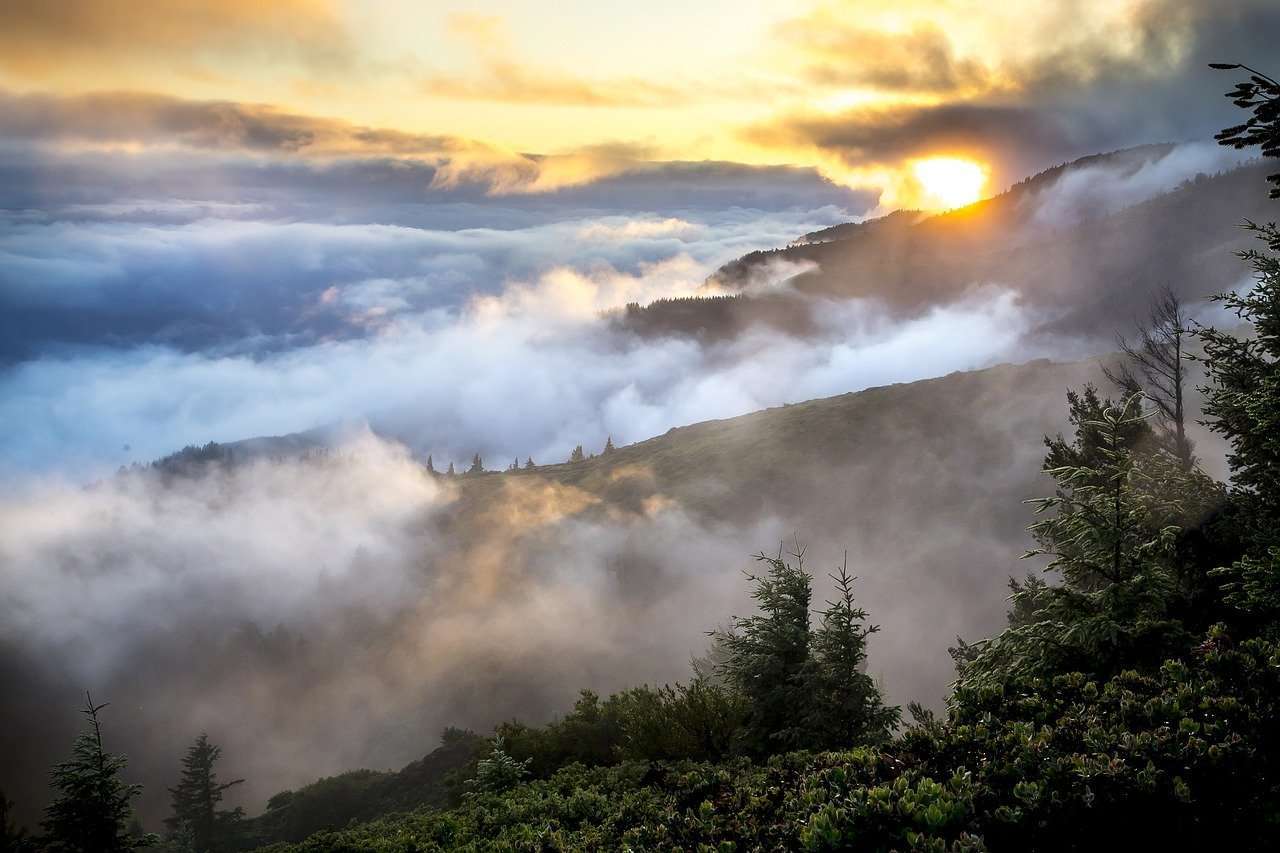
How to get there: Postcode PA27 8DJ. There’s a regular bus service from Dunoon which passes the entrance to the forest or you can drive there by following the A815 from Strachur.
Facilities: Car parking. Toilets. Picnic area. The Glenbranter forest office can be found near the car park which has toilets and maps if you want to venture deeper into the area. There’s also a hide where you can watch the forest’s wildlife.
Highlights: Located in one of the prettiest regions of Scotland, Glenbranter is full of waymarked trails that crisscross the surrounding forests.
The trails are suitable for all ages and fitness levels and vary from short strolls to feet-smashing all-day hikes, so take a look at the map in the car park to decide which route will be suitable for you. If you have children with you, you might like to check out the Broadleaves and Glen Eck trails which are one and two miles respectively across gravel surfaces that alternate between flat sections and long steep slopes.
The wildlife in this forest is abundant and you’re virtually guaranteed to see buzzards, red squirrels, roe deer, and woodpeckers on any of the walks, but if you want the best chance to see the animals you might consider getting on a bike and cycling along the twenty-one-mile Loch Eck trail. Just be warned some parts of the trail are quite steep so you’ll need a reasonable level of fitness to complete it.
Kilmun Arboretum
How to get there: Postcode PA23 8SJ. From Dunoon village follow the A815 north for around four miles to reach Kilmun. The arboretum is located at the western end of the village. A regular bus service operates between Dunoon and Kilmun pier which is a ten-minute walk from the entrance.
Facilities: Car park. Picnic area. More facilities can be found in Dunoon.
Highlights: This arboretum was planted in the 1930s as a way to test how various species of foreign trees would survive the changeable Scottish climate. At the time more than 260 different types of trees were planted and while not all of them have survived many have flourished – as you’ll see when you meander through the copices of sequoia, redwoods, maple, beech and firs.
This isn’t a particularly large forest and the longest walking trail shouldn’t take much more than an hour to complete, but it’s still worth visiting if only to see the collections of trees that you won’t find anywhere else in Scotland, such as the grove of eucalyptus that normally only grows in Australia.
Most of the mile-long path around the arboretum is gravel but there are a few grassy sections to cross along with a couple of steep slopes and narrow bridges.
Pucks Glen
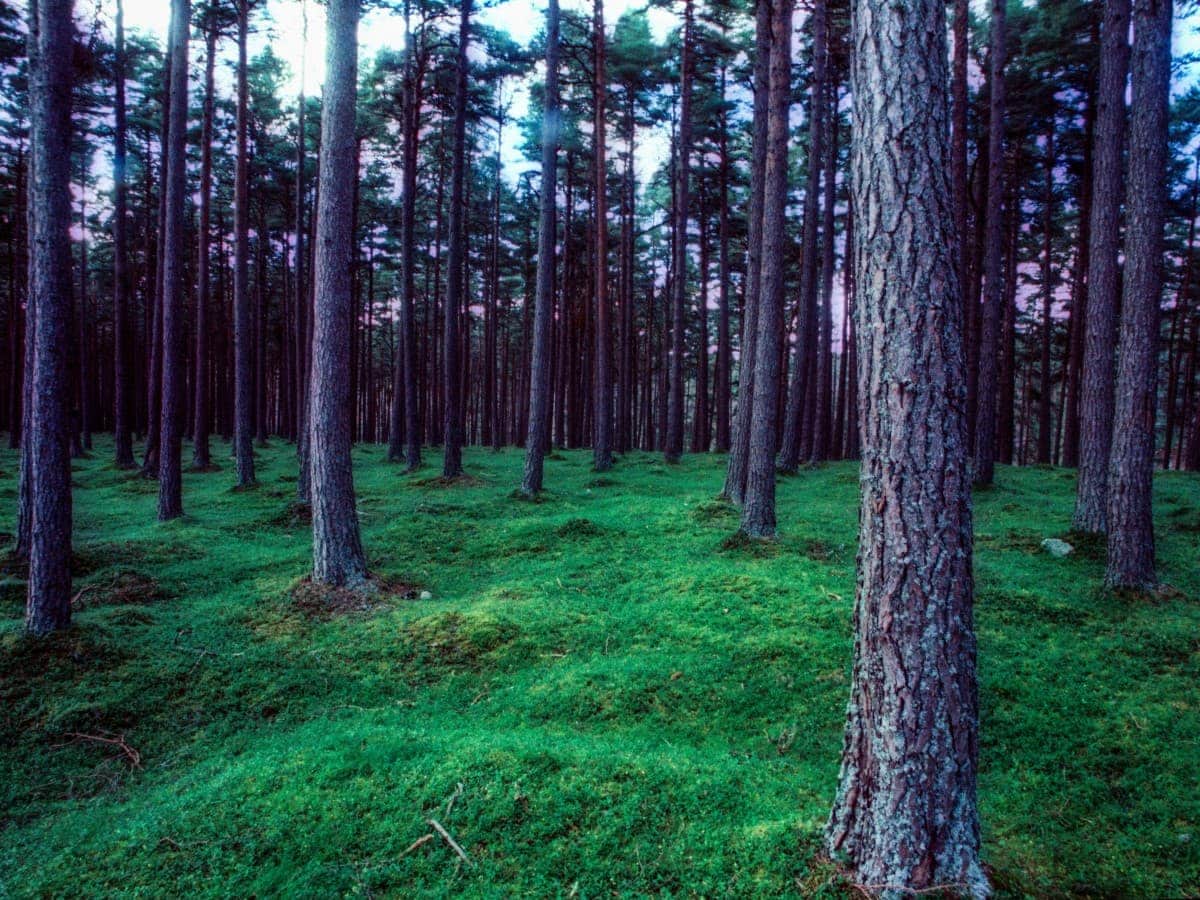
How to get there: Postcode PA23 8QT. You can get to Pucks Glen either by walking one mile from Benmore Botanic Gardens, driving to Inverchapel Forest car park on the A815 and walking, or taking the bus from Dunoon which is five miles away.
Facilities: Car park. Toilets. The village of Dunoon is nearby which has several places to eat, or you could visit Benmore Botanic Gardens which has toilets and a café. The gardens are just over a mile away on the A815.
Highlights: This lovely woodland walk follows a deep gorge that’s renowned for being a magical place. The trail was originally created in Victorian times and has since become very well known so you’ll see it on almost all tourist maps of the area.
The path that follows the gorge is quite short at two miles in length but it’s relatively steep and some sections are hard going when it’s wet, with some parts that become a muddy quagmire after a good rainfall. The walk is well worth the effort though and you’ll find tumbling waterfalls, towering ferns, and secluded gulleys from start to finish. If you have children, Pucks Glen offers a great family adventure.
After you’ve visited the glen I recommend driving the scenic A880 which follows the Cowal Peninsula alongside the Firth of Clyde, or you can visit the nearby Benmore Botanic Garden which is one of the highest-rated managed gardens in Scotland.
Galloway Forest Park
Clatteringshaws
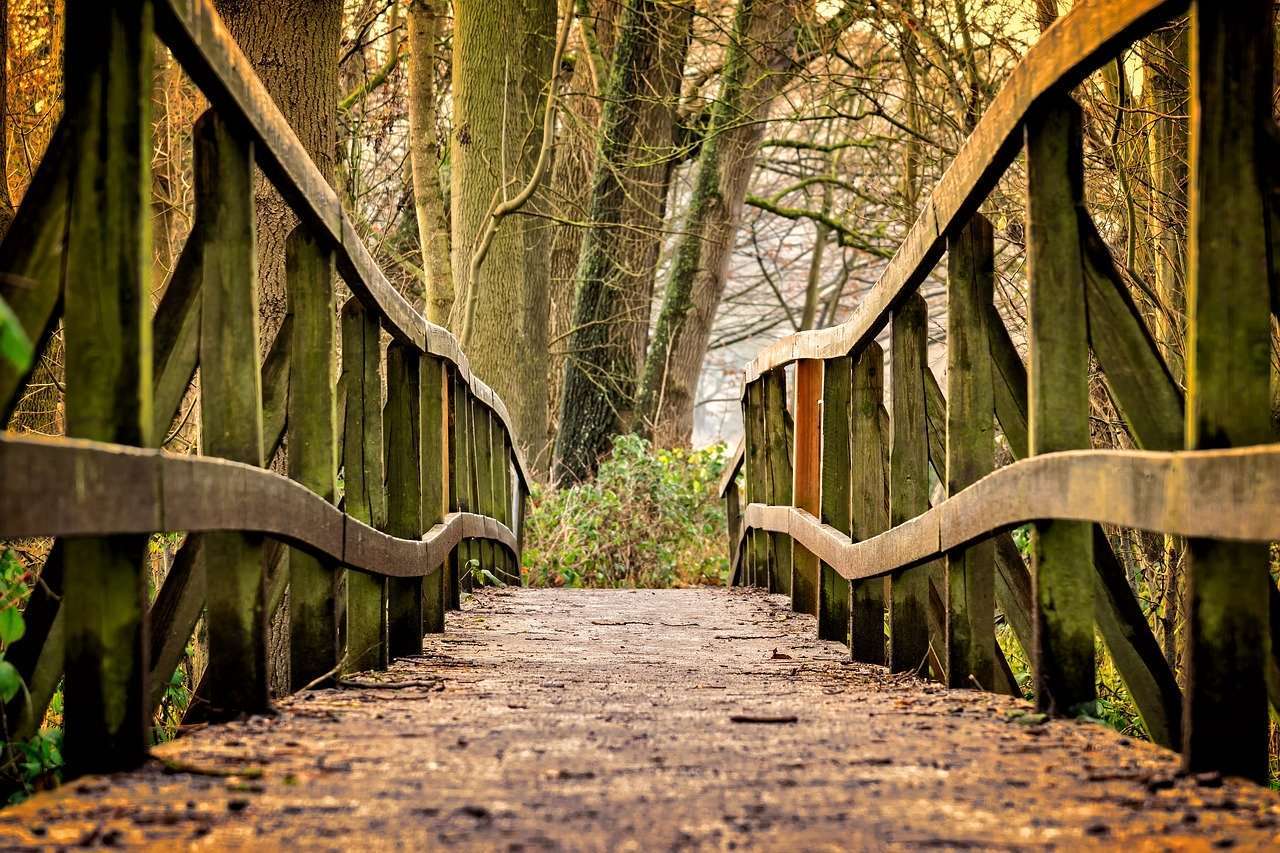
How to get there: Postcode DG7 3SQ. Clatteringshaws Forest is located between the villages of New Galloway and Newton Stewart on the A712. The visitor centre is next to the main entrance on the shore of Clatteringshaws Loch.
Facilities: Paid car park. Toilets. Café. Visitor information centre.
Highlights: This stunning forest surrounds a tranquil loch that’s a haven for wildlife. Just like at Loch Morlich, Clatteringshaws features rolling mountainous peaks in the near distance and a walk in this forest wouldn’t be complete without venturing into the Galloway Hills afterwards.
There is a designated, waymarked trail that follows the loch’s shore and winds in and out of the forest before coming to rest at the Robert the Bruce-famous location. It’s quite a short trail (about one mile), so if you want to get a bit more active, you should consider hopping on a bike to cycle the number 7 national cycle route, which starts in Glasgow and passes through Clatteringshaws before finishing at Carlisle.
Due to the number of lochs and lochans in the area, Clatteringshaws is a haven for wildlife and it’s a favourite nesting site for red kites, willow warblers, and even the occasional osprey. The forest has also been designated as a dark sky park, so if you want to see the Aurora Borealis unobscured by light pollution you might consider staying after the sun goes down.
Glentrool
How to get there: Postcode DG8 6SZ. From Glentrool village follow the signposted minor road that leads to the Glentrool visitor centre where you’ll find the car park.
Facilities: Paid car park. Visitor centre. Toilets. Café.
Highlights: As one of Scotland’s premier mountain biking trails, Glentrool is incredibly popular with bikers who visit in droves to experience the high-speed thrills the 36-mile cycle route offers. But it’s not all action when you bring your bike to this forest as there are several family-friendly trails to enjoy as well, with leisurely routes passing through the scenic Palnagashel Glen.
Alternatively, if you feel up to a bit more exertion you might prefer the ‘big country route’ that circles Galloway Forest Park for 36 miles along country tracks, forest paths and minor roads. If you’d rather stick to two feet there are lots of walks in this part of the forest that range from one to six miles in length. While the majority are easygoing, some sections are quite steep, so bear that in mind if you have young children with you.
Glentrool is one of the best forests in Scotland to go wildlife watching and it’s buzzing with birdlife so while you’re enjoying the scenery make sure you keep your eyes open for great tits, crossbills, and goldcrests, as well as the occasional red squirrel and herds of roe deer.
Kirroughtree Visitor Centre
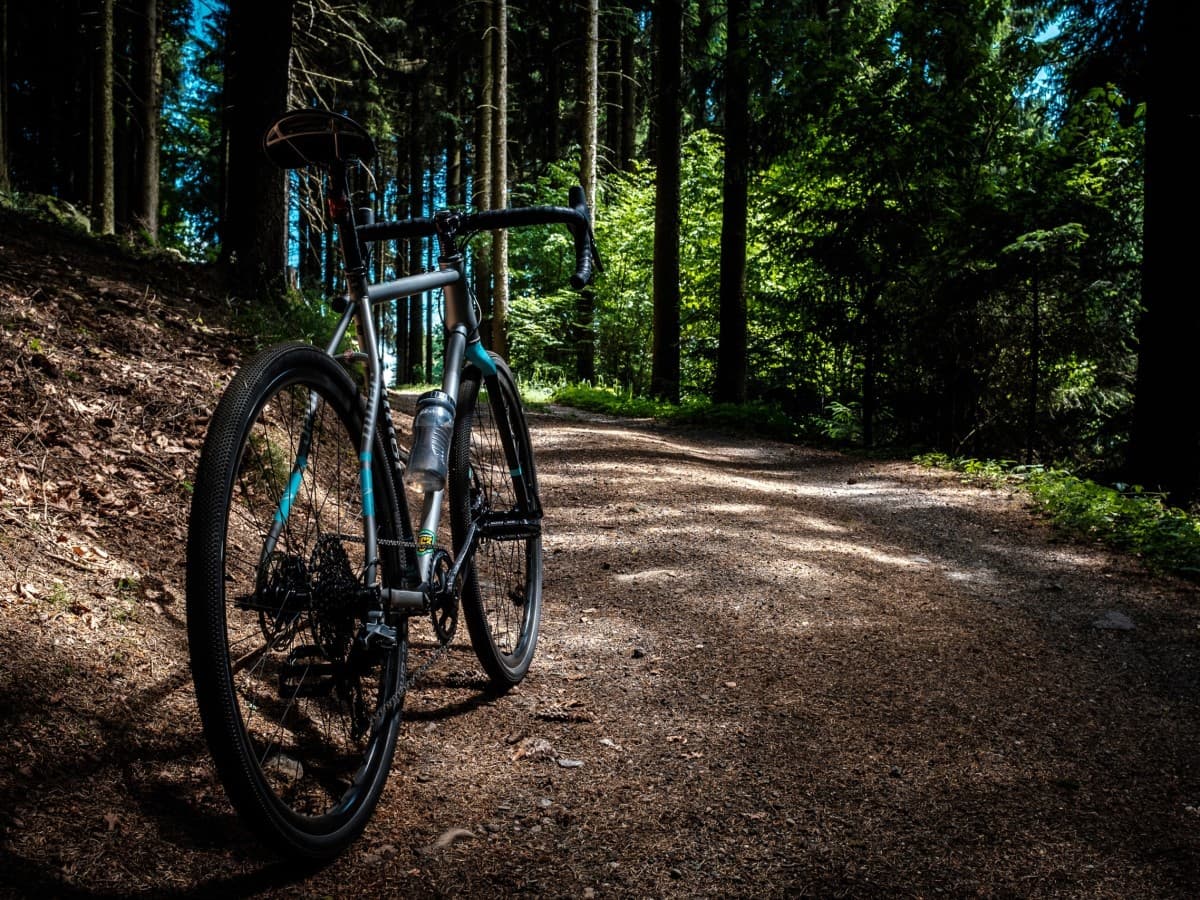
How to get there: Postcode DG8 7BE. Kirroughtree is well signposted on the A75 from the village of Palnure which lies 1 mile south of Newton Stewart.
Facilities: Toilets. Paid car park. Café. Visitor centre and information hub. Shop. Children’s play area. Bike hire. Showers. Picnic area.
Highlights: Of all the forests that make up Galloway Forest Park, the one at Kirroughtree is by far the most popular, primarily because of the wide selection of facilities on offer.
Having visited it myself on many occasions I can see why this forest attracts so many visitors as there’s something to do for all ages and abilities, whether that’s families looking for a short walk with their toddlers or adrenaline junkies searching for extreme downhill bike runs. The mountain biking at Kirroughtree, in particular, is first class and there are a variety of trails that feature grades ranging from green to black so everyone will be able to test their skills on two wheels.
I have to make a particular point about the 6-mile Larg Hill mountain biking trail, which is a winding route with amazing views up the 176-metre Larg Hill on a track that’s easily cycled but offers enough twists and turns to give the kids a good workout. Alternatively, the cycle route through Bargaly Wood is ideal for younger children as the route is almost entirely flat and has level farm tracks.
Visitors who aren’t in the mood for two-wheeled antics will have a great time on two feet thanks to several trails that range from easy to strenuous. The Little Bruntis Trail takes a slightly longer route through mixed woodland where the remains of old tin mines are visible, while the Wild Watch Trail provides disabled access into the forest to feeders that woodland birds frequently visit.
Both routes offer a good chance to watch Kirroughtree’s famed herds of roe deer and there’s every possibility of a sighting of a red squirrel or two as Galloway Forest Park is one of the few remaining British forests where red squirrel numbers are stable.
Book Tours in Scotland
Glenmore Forest Park
Allt Mor
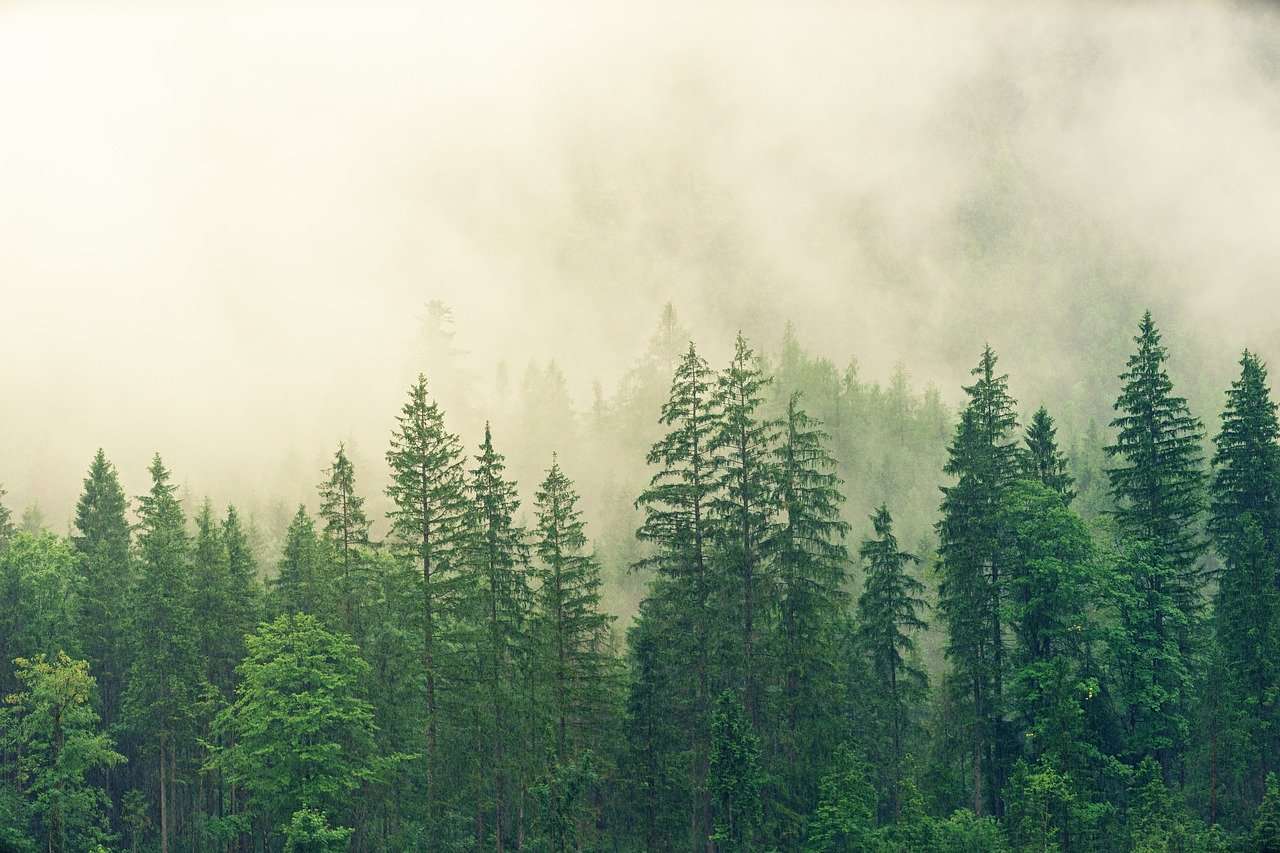
How to get there: Postcode PH22 1RB. From the Highland town of Aviemore head towards the Cairngorms for 7 miles. You’ll see the entrance for Allt Mor a mile past Glenmore forest. There’s a bus that goes between Aviemore and the Cairngorm ski centre which stops near Allt Mor, or you can cycle on a path between the forest and Aviemore.
Facilities: Paid car park. Picnic area. There aren’t any other facilities but it’s only a mile down the road to Loch Morlich which has a café and toilets.
Highlights: Just like the nearby Glenmore Forest, Allt Mor is a stunning area that’s full of thick pines, tumbling waterfalls, and an occasional loch. There’s a forest trail on a wide gravel surface that runs for around two and a half miles in a circular route into the forest and back to the car park. It’s quite a gentle stroll, but there are a couple of steep slopes, although they’re nothing that’ll get your heart pumping too much.
If you want a slightly longer walk you might like to follow the path that joins the Glenmore forest near Loch Morlich where you can visit the Green Lochan. This extra trail will add another mile and a half onto your walk (but it’s well worth doing).
Glenmore Visitor Centre
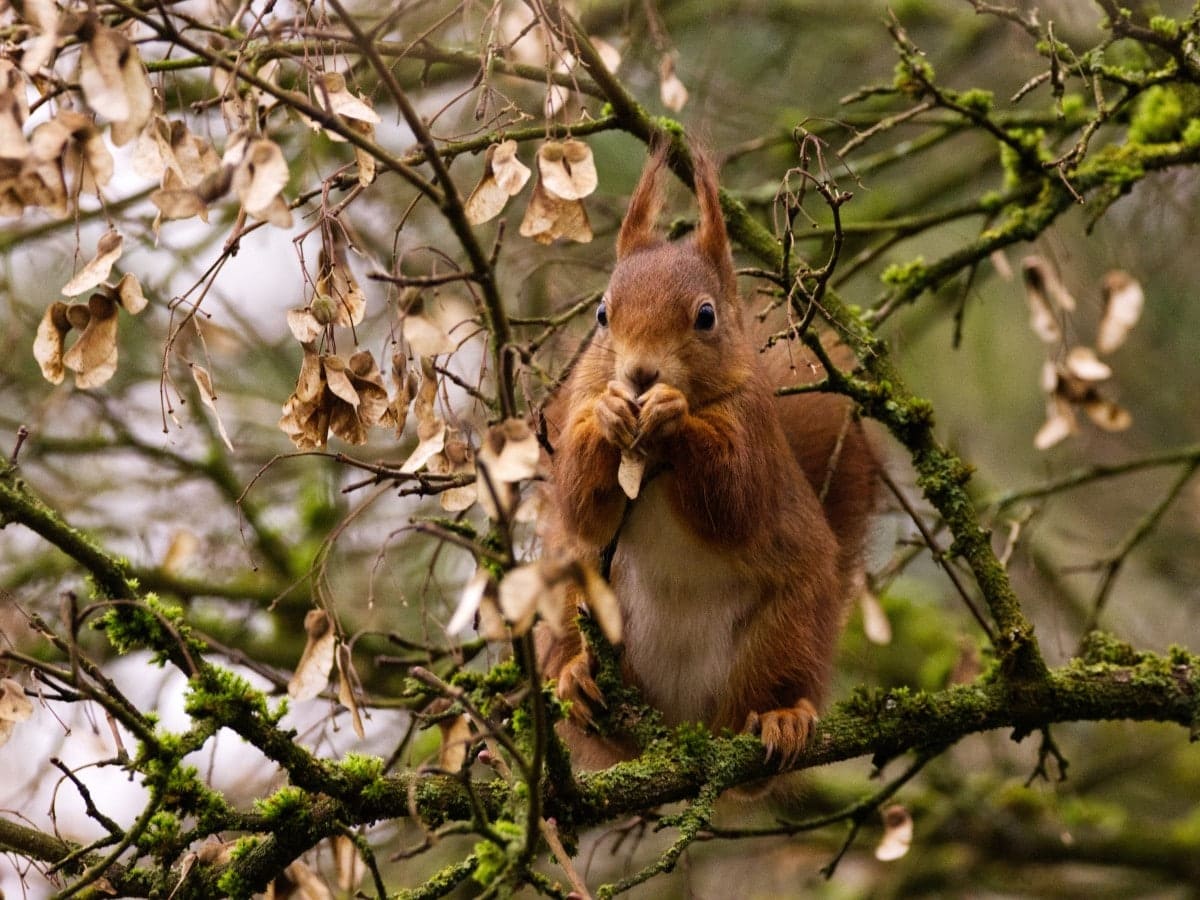
How to get there: Postcode PH22 1QU. From Aviemore follow the signs for the Cairngorms heading towards Loch Morlich. The Glenmore Forest visitor centre is 6 miles from Aviemore and there’s a connecting path so you can either cycle or walk there as well as drive.
Facilities: Toilets. Paid car park. Partially disabled facilities. Café. Visitor centre.
Highlights: From the visitor centre follow the trail to the summit of Meall a’ Bhuachaille which offers superb views from the 2,600-foot peak. You’ll be able to see across the Cairngorms in the distance with the glistening waters of Loch Morlich below.
A stunning location, Loch Morlich even has its own beach, which is the highest in Britain, and coniferous forests surround it. There’s a visitor centre where you can grab a bite to eat, and sports equipment can be hired out from the loch-side operators.
Another popular trail winds through the pine and birch forest to a small loch (An Lochan Uaine) which takes around two and a half hours to complete the three-and-a-half mile route. It’s a favourite area for red squirrels so you might see the odd one scampering about on the lookout for tasty pine cones.
Hayfield
How to get there: Postcode PH22 1RB (Cairngorm ski centre which is near Hayfield). From Aviemore head towards Glenmore Forest Park. You’ll find the signs for Hayfield about half a mile past the Glenmore visitor centre turning.
Facilities: Paid car park. Picnic area. There are more facilities at Loch Morlich and Glenmore Forest which is a 20-minute walk away.
Highlights: Like the trails along Loch Morlich, Hayfield features firm gravel paths through a mostly flat pine forest, with a couple of steep slopes thrown in for good measure. The waymarked trails in this region of Glenmore Forest Park are quite short (not quite two miles) but are full of wildlife, so it’s a great place to take the kids on a mini forest safari.
Expect to see lots of dragonflies as you make your way past numerous pools of water and keep your eyes open for wood ants hard at work making their nests. If you want to extend your walk or enjoy other activities the Cairngorm Ski Centre is just over three miles in one direction and Loch Morlich is half a mile in the opposite direction which has lots of water sports equipment to hire in the summer months.
Uath Lochans
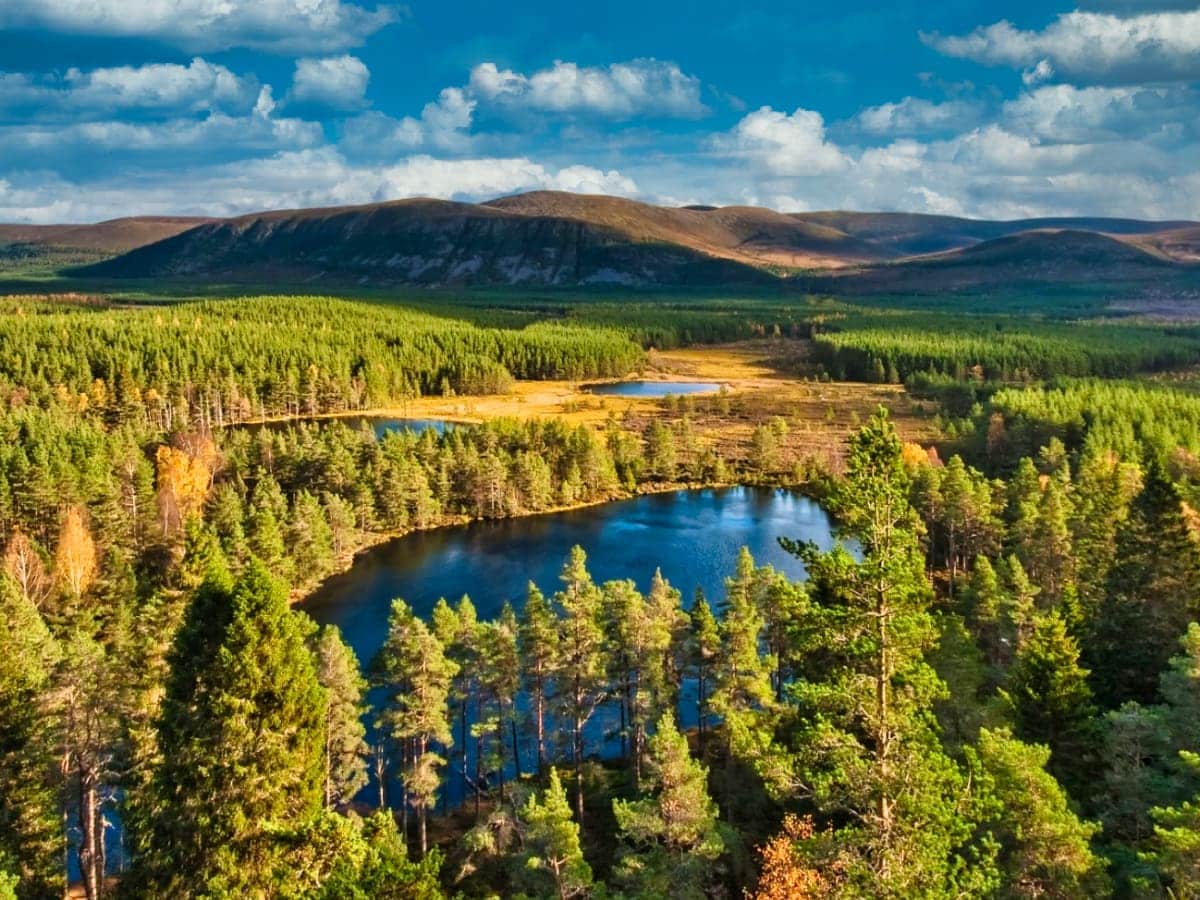
How to get there: Postcode: PH21 1NU. Getting to Uath Lochans is a wee bit tricky as the roads leading to it are rather remote, so the best option is to head to Loch Insh, which lies directly east of the Highland Wildlife Park.
From the village of Kincraig, follow the road on the north edge of Loch Insh and join the B970 at Insh village. Next, take the single-track road signposted to Glenfeshie and continue along it to the sign pointing to the Uath Lochan car park.
Facilities: Free parking. Picnic area.
Highlights: Uath Lochan is one of the most scenic woodland areas in the Highlands, and it’s somewhere that I highly recommend visiting, if you manage to find it, of course. There are four lochans inside the forest that are close to one another and have trees surrounding them except for an open patch of grassland in the middle.
Visitors can explore the lochans on two waymarked trails that offer short but very enjoyable walks, with one trail that zigzags between the bodies of water before returning to the starting point in the car park and another that diverts north up fairly strenuous slopes onto Farleitter Crag.
Mountain bikes can use both routes, but they should be aware that these trails are footpaths, so they should go as slowly as possible to avoid flattening unaware walkers at the numerous sharp bends in the trails.
The southernmost trail is by far the most scenic as it offers lovely views of the lochans, and if you can, I definitely recommend visiting in the summer. The lochans spring into life in the warmer months and children will have a great time watching the frogs and dragonflies at the water’s edge, as opposed to winter when there’s not much going on.
The slightly longer 2-mile route up Farleitter Crag doesn’t spend as long near the lochans but it does feature several viewpoints looking over the Spey valley which is very pretty indeed.
My advice if you really want to make the most of your time at this site is to combine both routes by starting at the car park, heading north through the forest, and then circling back south past Farleitter Crag. You can then join the waymarked path that follows the edges of the lochans before returning to the car park for a walk that will take around 3 hours in total.
Tay Forest Park
Craigvinean
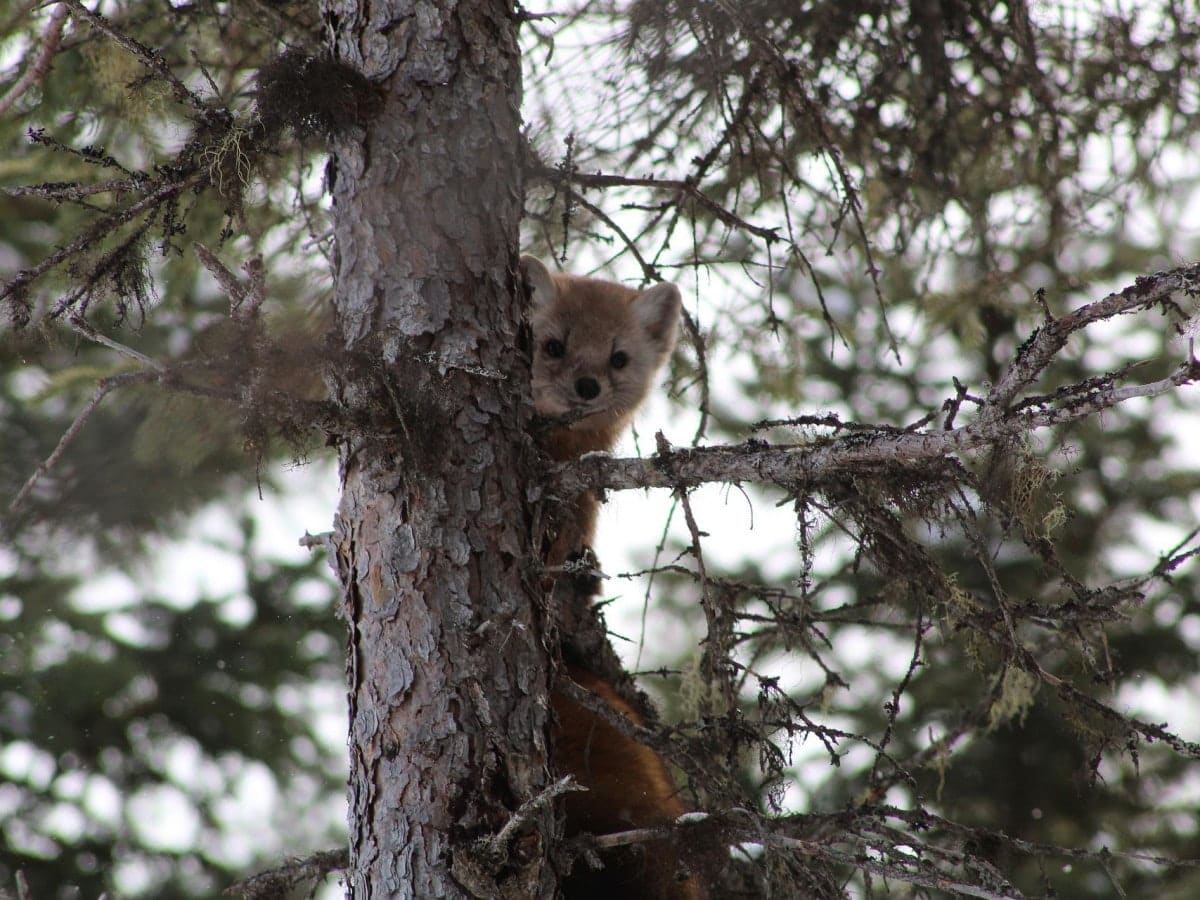
How to get there: Postcode: PH8 0JR. This forest is very easy to find, as it’s basically an extension of The Hermitage. The best option for visiting is to follow the A9 north of Dunkeld to the Hermitage car park, then take the Old Military Road into the forest, which ends at a small car park.
Facilities: Free parking. Burger van at The Hermitage car park.
Highlights: Perthshire’s Big Tree Country is best known for The Hermitage – the outdoors playground of the Dukes of Atholl that features several Victorian follies – but another managed forest created by the Dukes of Atholl lies immediately north at Craigvinean.
Just like The Hermitage, Craigvinean Forest takes visitors on trails that stop at a number of memorable viewpoints via footpaths that are well maintained and suitable for all ages and abilities. The two waymarked trails through Craigvinean are short at 1 and 3 miles but meet in the middle so can be combined into a single walk that will take around 2 1/2 hours to complete.
The 3-mile Pine Cone Point trail finishes at a bizarre pine cone-shaped structure with stunning views over the River Tay, while the 1-mile Torryvald Trail circles the area of forest from the car park to a Victorian Folly near the point where the two trails meet.
Both routes are suitable for slow rides on mountain bikes but the path is quite narrow in places so care should be taken when nearing bends in the path. Walkers should have no problems on either path as they’re well-used and mostly compacted dirt, but they’re not suitable for wheelchairs and there are no facilities in Craigvinean at all except for the car park.
Faskally
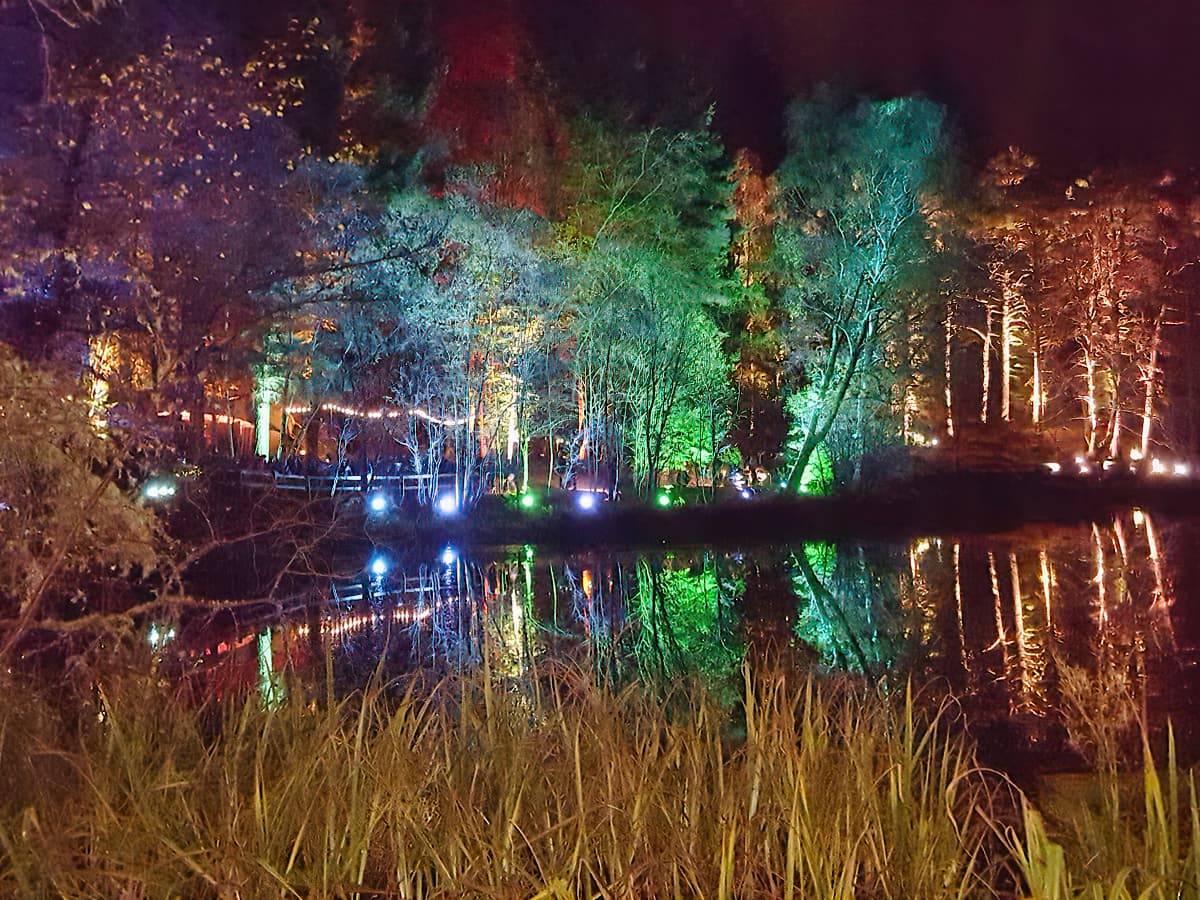
How to get there: Postcode PH16 5LB. From Pitlochry, follow the B8019 one mile north. If you’d prefer to use public transport there’s a bus service from Pitlochry.
Facilities: Car parking. Disabled access. Toilets. Picnic area.
Out About Scotland complete guide: The Enchanted Forest
Highlights: Faskally Forest is perhaps best known for the annual Enchanted Forest light and sound show that takes place each year in October. The show uses the natural backdrop of the forest as the stage for a spectacular event that lights up the trees in a mesmerizing display of colours that’s one of the highlights of Scotland’s events calendar.
For the rest of the year, Faskally offers pleasant walks through a woodland that was created in the 19th century for the owners of Faskally House. It’s not exactly what you’d call an ancient woodland, but it’s still worth visiting because it offers a simple walk on sturdy paths that is accessible to people of all ages and abilities.
The forest centres around Loch Dunmore which is a haven for wildlife and you’re almost guaranteed to see kingfishers, herons, swans, and ornamental ducks on and around the water which makes the one-and-a-half-mile path a real pleasure to stroll along.
The burgh of Pitlochry lies a couple of miles to the southeast and has a good selection of cafés and restaurants, while the village of Killiecrankie, a few miles north, marks the start of Cairngorms National Park.
Queen’s View Visitor Centre
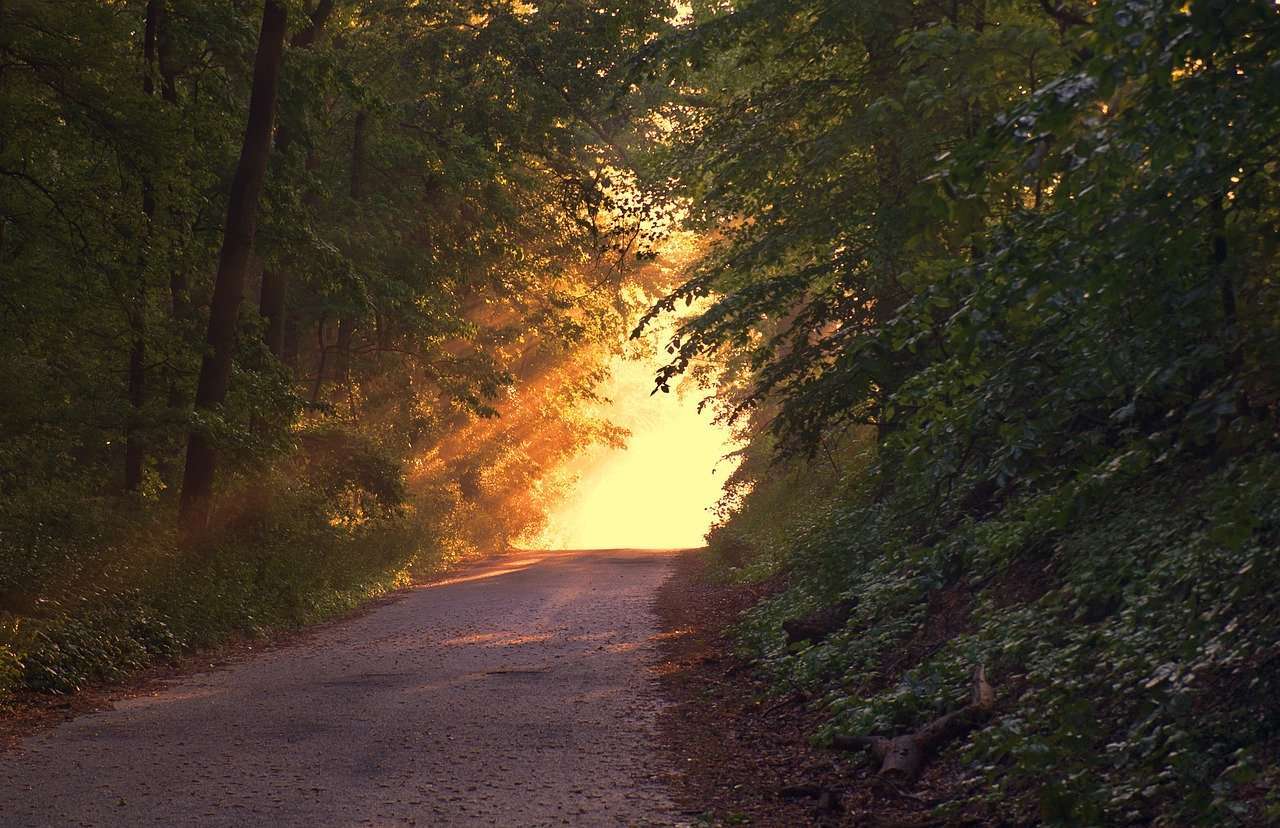
How to get there: Postcode PH16 5NR. From Pitlochry follow the A9 towards Killiecrankie then take the B8019 towards Strath Tummel. The Queen’s View visitor centre is signposted from the start of Loch Tummel.
Facilities: Paid car park. Disabled access. Café. Visitor centre. Toilets. Shop.
Highlights: The iconic Queen’s View in Perthshire is famous for being one of Queen Victoria’s favourite places in Scotland, although it’s actually named after the wife of Robert the Bruce, who lived five hundred years before Victoria. The views across Loch Tummel and the forests beyond are certainly fit for a queen, and a visit to the viewing platform is one of those must-do moments for anyone in this part of Perthshire’s ancient woodland.
Tay Forest Park extends to the north of the loch and there are plenty of scenic paths to explore, although it’s admittedly not as heavily wooded as the other forests in this list due to the broad sweeps of heather-covered hills that break up the terrain.
It’s a very quiet region of Scotland though, so if you’re looking to escape the world and lose yourself amongst the trees it comes highly recommended as you can walk for miles without seeing other visitors. If you prefer a slightly more ‘touristy’ forest you could always head south on the A9 to visit The Hermitage Forest instead.
Weem
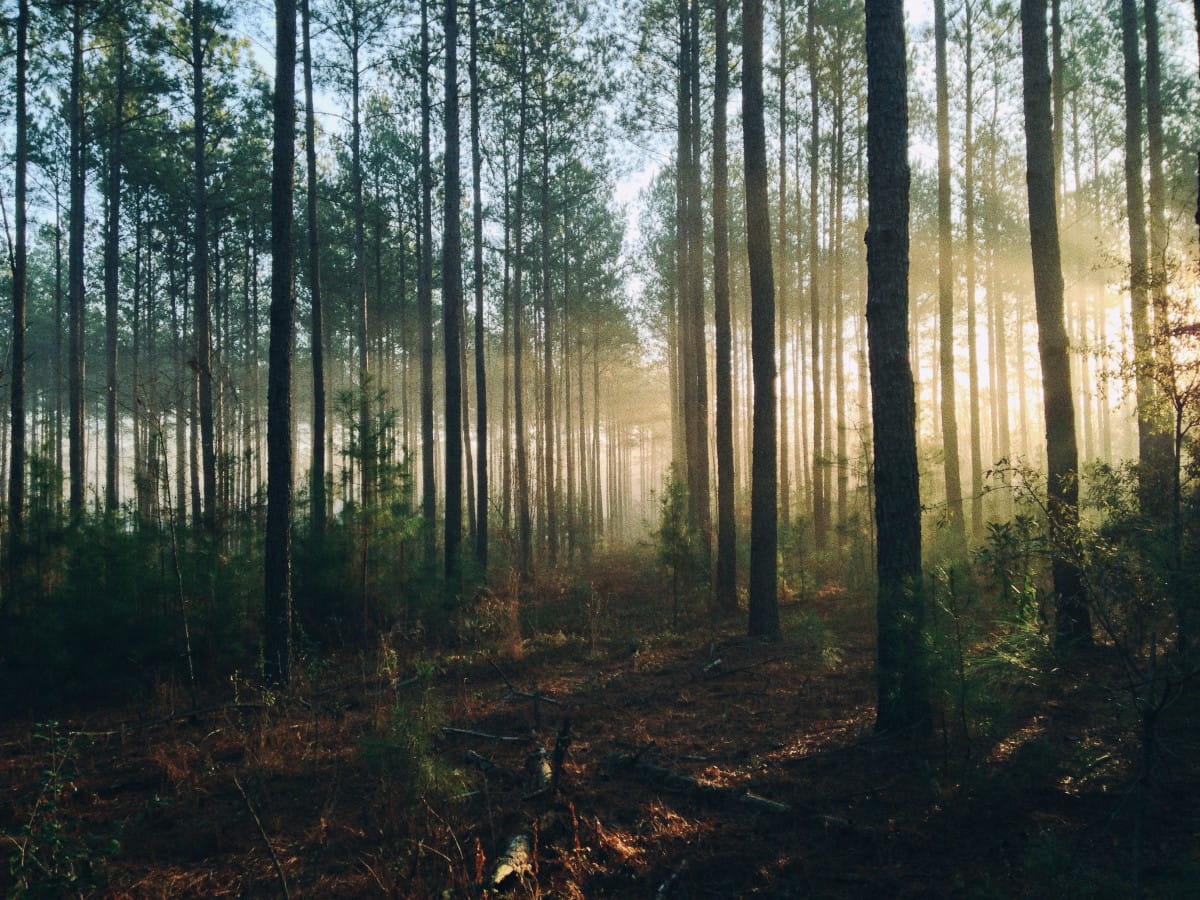
How to get there: Postcode PH15 2JD. This woodland lies less than a mile west of the village of Weem near Aberfeldy. You’ll find the car park close to the signposted turn-off to Castle Menzies.
Facilities: Free car park.
Highlights: Weem Wood is probably the smallest woodland in this list, but it’s worth a visit for anyone who’s in the area to see the 16th-century Castle Menzies. The wood lies behind the castle and extends in an easterly direction towards St. Davids Well which is the former home of a 15th-century hermit who was a member of the Menzies clan but renounced his heritage.
Getting to the cave of St. David’s Well involves a fairly arduous climb up a narrow track that passes through thick woodland where occasional glimpses of the River Tay can be seen. Visitors should keep an eye out for sculptures from the St. David story hidden among the trees along the 1-mile route. Some artworks depict the woodland’s mythical use by ancient enchanters who imprisoned people inside the rocks that form the backdrop of Castle Menzies.
Folklore aside, Weem Wood is a very scenic place that offers a pleasant walk that shouldn’t take much more than an hour. There are no facilities other than the car park but Aberfeldy village is close by which has several cafés, and the famous Birks of Aberfeldy woodland is a few minute’s drive away which often has a burger van in the car park.
Protect Your Family From Scotland's Biting Midges
- Powerful, reliable protection for up to 8 hours
- Water- and sweat resistant
- Repels midges, mosquitoes, horse flies, sand flies, fleas and ticks
- Safe for use on adults, children over 30 months and pregnant women
- Non-sticky, moisturising with a pleasant fragrance
- Packaging may vary
Tweed Valley Forest Park
Cademuir
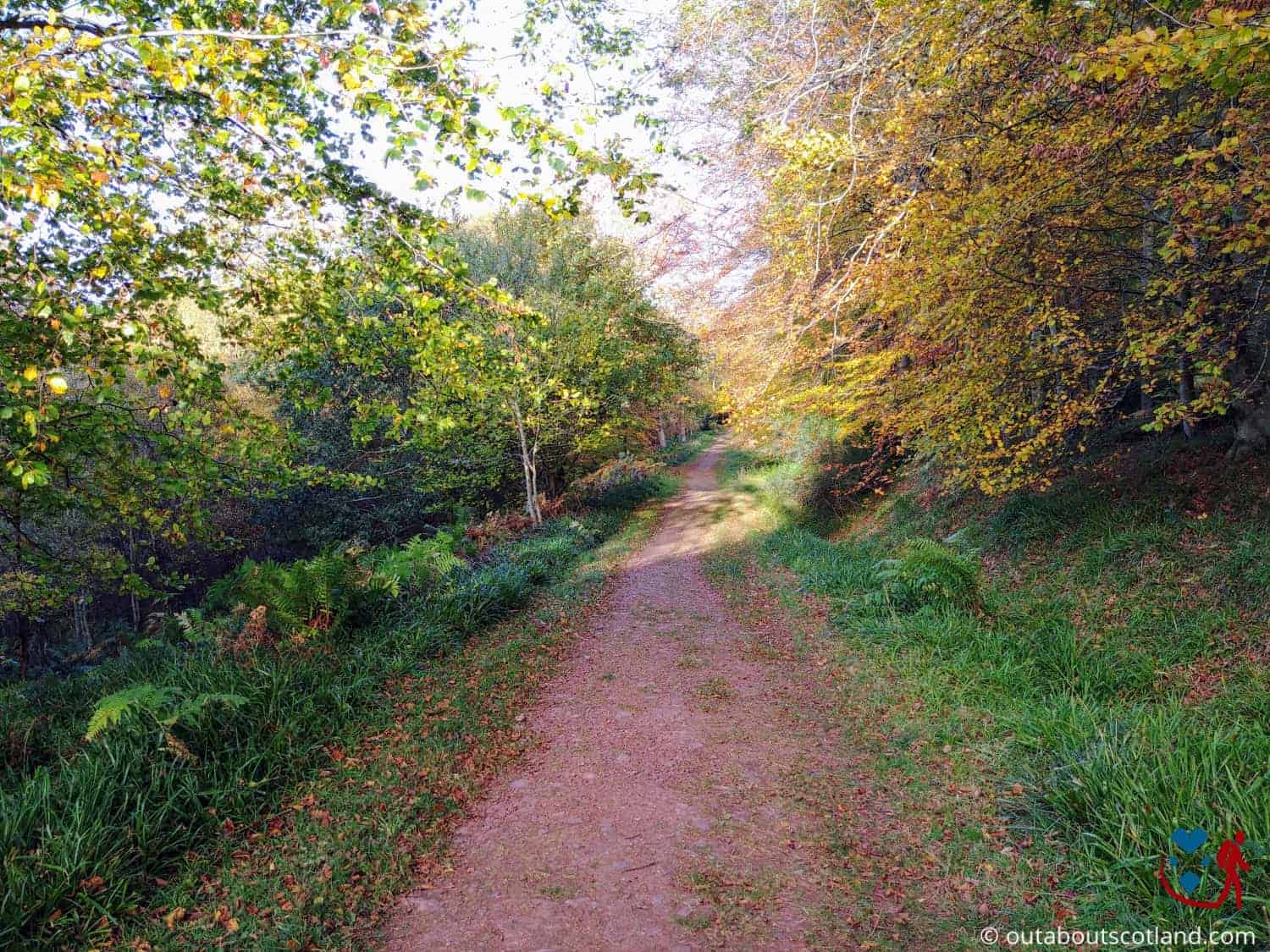
How to get there: Postcode EH45 9HH. Cademuir forest is easy to get to if you follow a sat nav. The signposted car park entrance is located on Bonnington Road near Peebles High School, around 2 miles south of Peebles town centre.
Facilities: Free car parking.
Highlights: Cademuir Forest is one of the few forests that can be reached from Edinburgh in less than an hour, which makes it an ideal destination for city-dwellers looking to breathe in the fresh country air of the Scottish Borders.
Admittedly it’s rather lacking in facilities compared to nearby Glentress Forest, but what it lacks in amenities it more than makes up for with its spectacular views across Peebles and the surrounding landscape from the top of Cademuir Hill.
It’s also one of the best areas in the region for wildlife spotting due to the fact that most people head to the forests of Glentress and Cardrona, leaving Cademuir in relative peace and quiet. Visitors will frequently catch sight of red squirrels and red deer foraging in the woods, while tawny owls can often be seen on the hunt for their next meal at dusk.
The forest is a favourite with birdwatchers thanks to its combination of woodland and open hillsides, so if you’re a twitcher, I suggest taking your binoculars as there are warblers, crossbills, woodpeckers, and many more birds to be seen during a walk along the trails that run through Cademuir.
The two designated paths through the forest are both comprised of firm gravel and compacted dirt, but they offer very different experiences.
The first path is a 1-mile walk through the trees on an easy-going level surface, while the other is a strenuous 4-mile hike up Cademuir Hill, which has steep slopes but fantastic views from the summit. Expect the shorter walk to take 1 hour and the longer to take 2 1/2 to 3 hours. Note that there are no facilities other than the car park, but Peebles town centre is a mere 5-minute drive away.
Cardrona
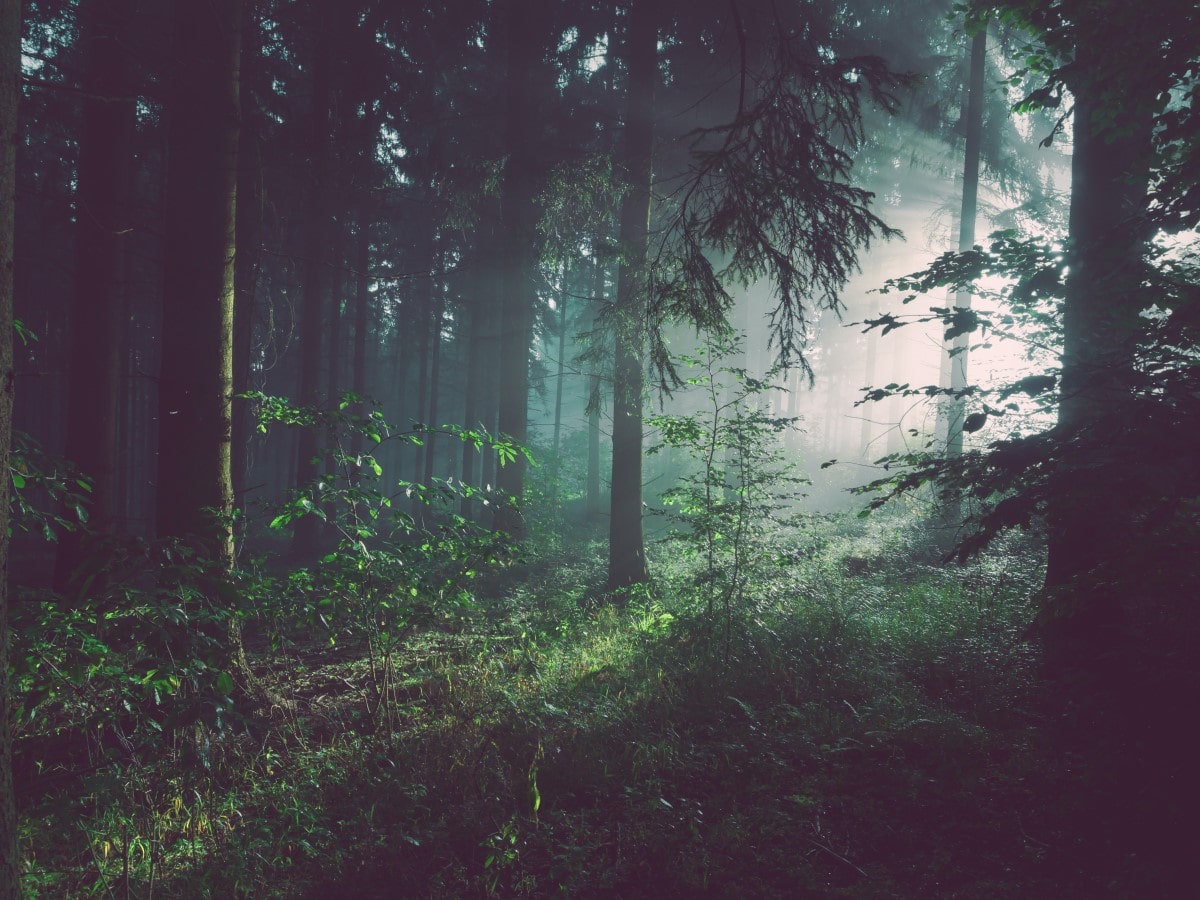
How to get there: Postcode: EH45 9HU. Cardrona lies midway between Innerleithen and Peebles in the Scottish Borders. From Peebles, follow the B7062 three and a half miles east, where you’ll see signs directing you to the forest car park.
Facilities: Paid car park. Toilets. Picnic area.
Highlights: Cardrona lies three miles south of Glentress Forest which makes it an ideal place to go for a walk if you’re looking for a quieter location than the mountain-biking mecca of Glentress. Although cyclists are allowed inside Cardrona, it’s a much gentler affair than Glentress, and the majority of the trails are easy-going paths as opposed to hairpin twisty-turny adventure courses.
Cardrona isn’t a particularly big area, but it’s exceptionally pretty thanks to the thick woodland that covers the southern hillsides of the Tweed Valley. It’s also full of history, with a couple of ruined forts to discover, one of which is thought to be over two thousand years old and another that’s protected as a home for bats.
Four walking trails have been laid out at Cardrona, which are all easy enough to follow thanks to well-maintained paths that are level and mostly comprised of gravel and loose stone. The shortest is a mere 1/3 of a mile, and the longest is four miles, so it’s an ideal place to go for a forest walk if you have children of any age.
Glenkinnon
How to get there: Postcode TD1 3LH. Glenkinnon is located midway between Selkirk and Innerleithen on the A707. Signs point to the forest car park from the main road near the village of Caddonfoot.
Facilities: Free car park. Picnic area.
Highlights: This is one of the smaller forests in the Tweed Valley but it makes a change from the busier forests that you’ll find to the north.
Unlike the ever-popular Glentress, Glenkinnon has no waymarked mountain biking routes, so it’s a quieter place to visit if you’d rather enjoy a peaceful walk through ancient ash, alder, and oak trees. This is one of the oldest forests in Scotland, but while it’s not quite up there with the thousand-year-old forests of Perthshire, it’s still an ancient woodland with some trees, such as the Glenkinnon Oak, that are over five hundred years old.
Well-maintained paths circle this woodland across grassland and along the banks of the River Tweed on a route that’s approximately one mile in length, but you can easily extend this by joining the paths to the south that meet the Southern Upland Way which is Britain’s very first coast-to-coast long-distance footpath.
Glentress
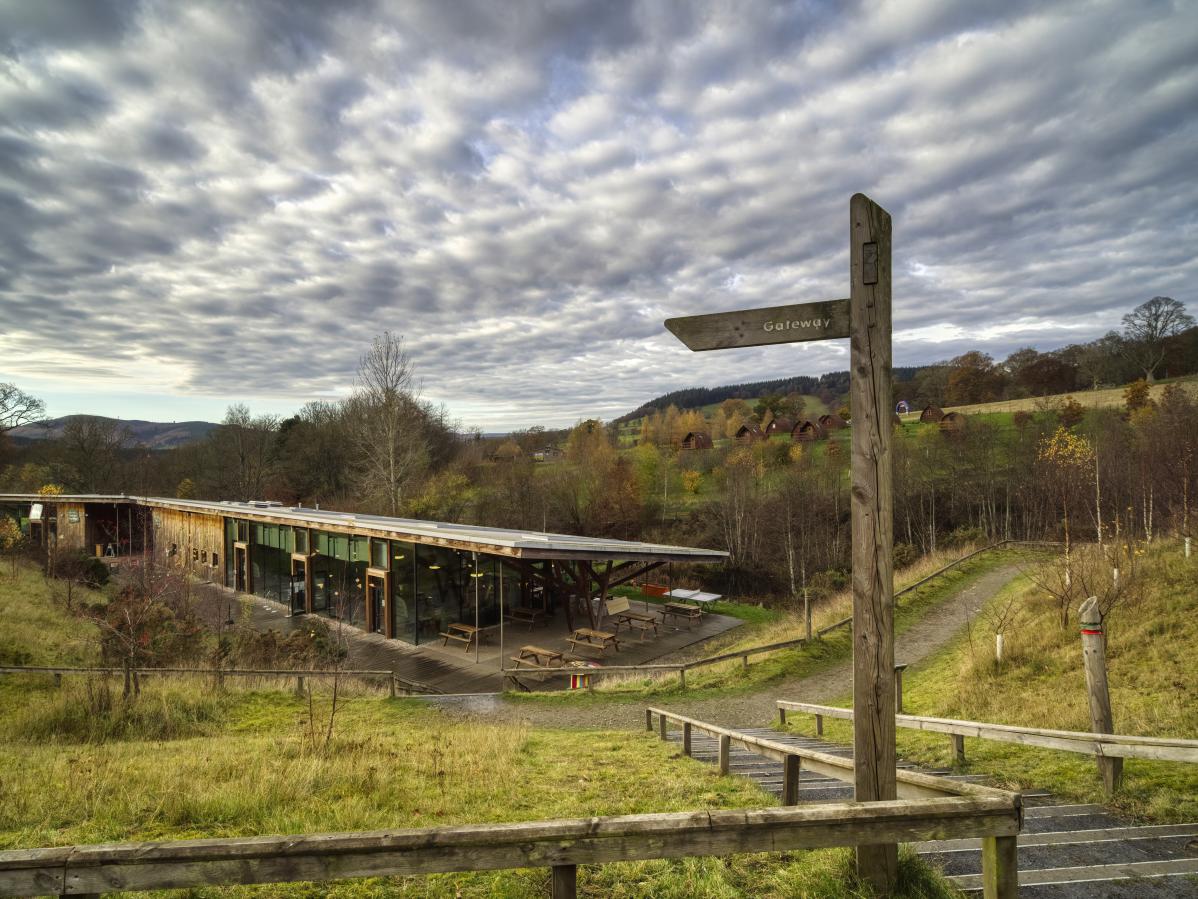
How to get there: Postcode EH45 8NB. The Tweed Valley forest park is easy to get to from Edinburgh and it’s well-signposted between Peebles and Innerleithen off the A72. Several bus services stop at Glentress including some from Edinburgh, but if you want to take your bike it’s best to carry it on your car as the A703 from Edinburgh is very busy.
Facilities: Paid car park. Toilets. Café. Disabled access. Visitor/information centre. Bike hire. Shower. Bike cleaning. Picnic area.
Highlights: Glentress is well known amongst the mountain biking community for having some of the best trails in Scotland, with routes suitable for all ages and fitness levels. From two-mile beginner trails to advanced eleven-mile rides you’re bound to find an enjoyable cycling experience in this forest.
But it’s not all about bikes at Glentress. If you’ve got children that need to burn off energy you can take them to the Go-Ape tree-top adventure course where they can climb rope ladders and traverse treetop wires forty feet above the forest floor, and there’s even a 100-foot-long zip wire that zooms between the huge Douglas Firs.
Those who prefer the gentler pursuits of walking will find five waymarked trails to follow that are separate from the cycle routes. Some routes like the Ponds Trail circle a wetland that’s home to herons and bats while others like the Tower Trail offer more of a challenge on a four-hour trek through mature woodlands and hills.
If you visit the forest with the intention of walking but end up wishing you’d brought your bike you can hire one from the visitor centre near the main car park, and there’s a café nearby that serves refreshments so you can wind down with a coffee at the end of a long day of tree-bound activities.
Queen Elizabeth Forest Park
Aberfoyle Visitor Centre
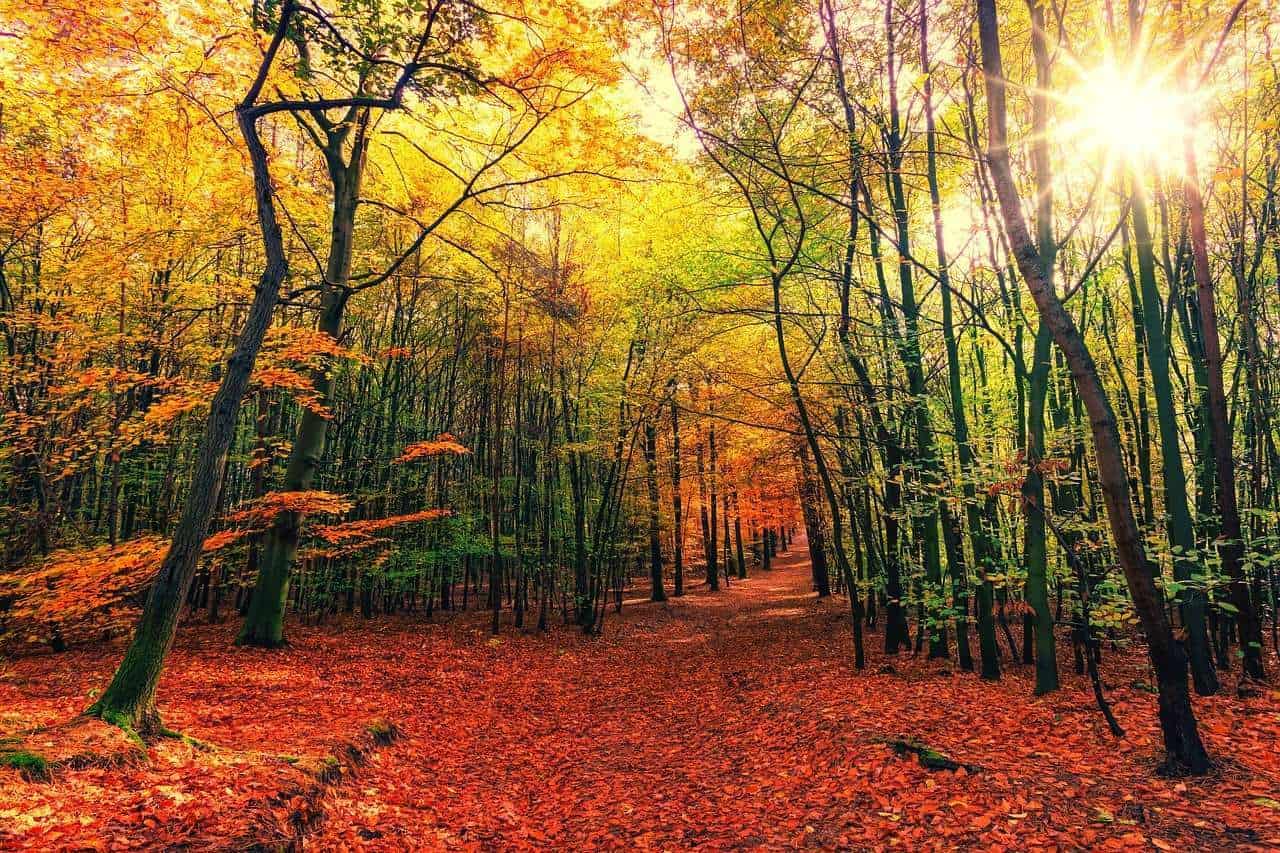
How to get there: Postcode FK8 3SX. The visitor centre is approximately one mile north of the village of Aberfoyle in the Trossachs National Park, just off the A821.
Facilities: Paid car park. Disabled access. Café. Toilets. Visitor information centre. Picnic area. Outdoor adventure course. Wildlife hides.
Highlights: The lodge in Queen Elizabeth Park is considered by many to be one of the best forest park sites in Scotland. FLS has installed heaps of facilities at this location, and in addition to the stunning walking and cycling trails, there’s a treetop rope-access adventure course, an excellent café, and live-action video feeds of the local wildlife.
A lot of effort has gone into making the forest accessible to all and while most people will be happy to walk the one to four-mile waymarked trails, visitors with disabilities can also enjoy the forest thanks to trails that have level gravel surfaces.
Waterfalls and artworks can be seen along the pathways, and some of the trails climb steep hills that lead to stunning views across Ben Lomond and Ben Ledi, which I’m sure will be enough to inspire you to explore the rest of the national park.
If you’ve any interest in Scotland’s wildlife you’ll have a great time in the forest surrounding the visitor centre with red squirrels, water voles, ospreys and more to be seen, and there are accessible hides to sit in if you want to photograph the woodland animals without disturbing them.
Loch Katrine
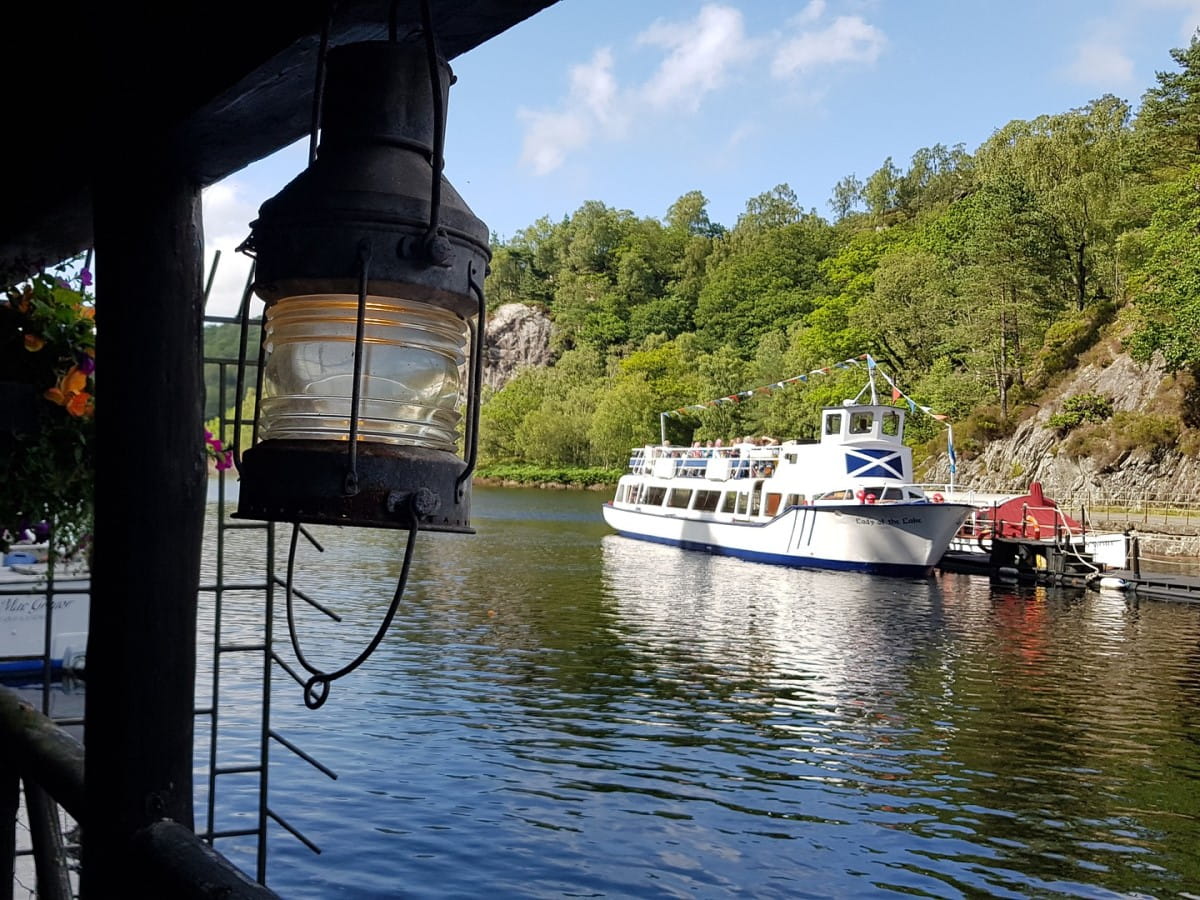
How to get there: Postcode FK17 8HZ. Loch Katrine is easy to find as it’s well-signposted from Aberfoyle and Kilmahog on the A821. You’ll find the car park six miles north of Aberfoyle and nine miles west of Kilmahog.
Facilities: Paid car park. Café. Bike hire. Shop. Picnic area. Toilets.
Highlights: You might not think a loch would be a good place to go for a woodland walk, but Loch Katrine sits in the middle of the Trossachs National Park, where it’s surrounded by ancient woodland.
Quieter than Loch Lomond, Katrine offers an equally enjoyable experience with well-maintained paths running throughout the area on routes that run deep into the heart of this spectacular setting.
If you’d rather not walk through the forest you can spend all day at the loch where there’s a café and steamboat rides as well as a few picnic spots. The highlight though, is the thirteen-mile path that follows the loch end-to-end and this picturesque route is practically begging to be explored on a bike. If you haven’t brought your two-wheeled friend with you there’s a bike hire shop near the Trossachs pier.
Rowardennan
How to get there: Postcode G63 0AR. Rowardennan is located on the eastern shore of Loch Lomond, around 12 miles north of Drymen. From Drymen, follow the B837 to Balmaha and continue to its endpoint at the Loch Lomond car park.
Facilities: Paid car park. Toilets. Picnic area. Tourist information. Food and drink can be purchased from the Rowardennan Hotel.
Highlights: Rowardennan is a woodland situated on the banks of Loch Lomond in the Stirling district of Central Scotland. As woodlands go it isn’t particularly big, but it’s a popular destination thanks to its location on the shore of the loch as well as the nearby footpath that ventures up to the summit of Ben Lomond mountain.
From the car park, visitors can enjoy shingle beaches that overlook the crystal waters of Loch Lomond as well as follow the West Highland Way which runs alongside the loch to Inverarnan and beyond. If you’re thinking of setting off on this famous walking trail from Rowardennan, you’ll find lots of useful information for your journey on the official West Highland Way website.
The hike up Ben Lomond, meanwhile, is far more arduous than the gentle incline of the starting point would have you believe, and adventurers should prepare themselves for an 8-mile round trip to the 974-metre summit that will take a good 5 hours for anyone with moderate fitness.
Sticking with Rowardennan, there is only one designated walking route, which is really just a wander around a memorial trail on the water’s edge. All ages and abilities can enjoy it because it is only 1/4 mile long and accessible via the car park.
Book Tours in Scotland
Facts About Scotland’s Forests
- As of 2020, around 19% of Scotland is covered by trees. That’s a big increase from 1919, when only 5% of the landscape was wooded.
- The Scottish Government owns approximately 1,800 square miles of Scotland’s forests and woodlands through Forestry and Land Scotland.
- Scotland’s forestry industry contributes over £1 billion to the nation’s economy.
- The industry currently employs around 25,000 people.
- The tallest tree in Scotland is a Douglas Fir near Inverness which is 218 feet high.
- The oldest tree in Scotland is the Fortingall Yew in Glen Lyon which is estimated to be between 3,000 and 5,000 years old.
- There are over one thousand different species of tree in Scotland.
- The native Scots Pine covers almost 12% of forest land in Scotland.
Resources
- Discover Scotland’s forests with the official Forestry and Land Scotland website.
- Support the regeneration of Scotland’s forests with Trees For Life.
- Find forest paths and woodland walks with Ordnance Survey maps. Buy OS Landranger maps direct from Ordnance Survey.
- Learn about Scotland’s wilderness areas with the Wild Guide Scotland book. Buy it from Amazon.
- Discover Scotland’s natural heritage at the nature.scot website.
Protect Your Family From Scotland's Biting Midges
- Powerful, reliable protection for up to 8 hours
- Water- and sweat resistant
- Repels midges, mosquitoes, horse flies, sand flies, fleas and ticks
- Safe for use on adults, children over 30 months and pregnant women
- Non-sticky, moisturising with a pleasant fragrance
- Packaging may vary
Frequently Asked Questions
What are the forest parks in Scotland?
Although there are 307 individual forests in Scotland managed by Forestry and Land Scotland, there are 6 forest parks, with each park comprised of groups of forests. The parks are Glenmore, Argyll, Galloway, Tweed Valley, Queen Elizabeth, and Tay Forest Park.
What is the largest forest in Scotland?
Galloway Forest Park in the west of Scotland covers 297 square miles or 770 square kilometres. The forest park is home to three forest visitor centres and two of the 7stanes mountain bike trails.
What wildlife can I see in Scotland’s forests?
Golden eagles, white-tailed eagles, badgers, wildcats, red squirrels, roe deer, red deer, capercaillie, grouse, beaver, adders, buzzards, pine martens, red kite, osprey and stoats, amongst others.
Which Scottish forests are good for mountain biking?
Achnabreac, Balblair, Carron Valley, Contin, Dalbeattie, Deuchny Hill, Forest of Ae, Glentress, Innerleithen, Laggan Wolftrax, Learnie Red Rocks, Mabie, Newcastleton, Pifichie, Wauchope and Winding Walks.
What kind of forests are in Scotland?
Scotland is home to a variety of forests that include coniferous and deciduous trees. Some of the most common trees found in Scottish forests include Scots pine, oak, and birch.




